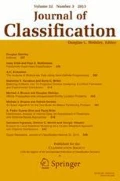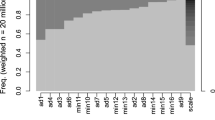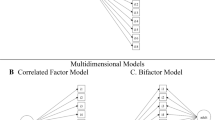Abstract
This paper addresses measurement error in food security in the USA. In particular, it uses a Bayesian 4-parameter IRT model to look at the likelihood of over- or under-reporting of the conditions that comprise the food security module (FSM), the data collection administered in many US surveys to assess and monitor food insecurity. While this model’s parameters are only partially identified, we learn about the likely values of these parameters by using a Bayesian framework. My results suggest significant under-reporting of more severe food security items, particularly those in the child module. I find no evidence of over-reporting of food hardships. I show that, under conservative assumptions, this model predicts food insecurity prevalence between 1 and 3 percentage points higher than current estimates, or roughly 4 to 15 percent of prevalence, for the years 2007–2015. Results suggest much larger increases—on the order of 50 percent of prevalence—for very low food security among households that were screened into the food security module.



Similar content being viewed by others
References
Aitkin, M. (2016). Expectation maximization algorithm and extensions. In van der Linden, W.J. (Ed.) Handbook of Item Response Theory, (Vol. 2 pp. 217–236): CRC Press.
Albert, J.H. (1992). Bayesian estimation of normal ogive item response curves using Gibbs sampling. Journal of Educational and Behavioral Statistics, 17(3), 251–69.
Albert, J.H., & Chib, S. (1993). Bayesian analysis of binary and polychotomous response data. Journal of the American Statistical Association, 88(422), 669–679.
Beguin, A.A., & Glas, C.A.W. (2001). MCMC Estimation and some model-fit analysis of multidimensional IRT models. Psychometrika, 66(4), 541–562.
Bock, R.D., & Aitkin, M. (1981). Marginal maximum likelihood estimation of item parameters: application of an EM algorithm. Psychometrika, 56(4), 443–459.
Coleman-Jensen, A., Rabbit, M.P., Gregory, C.A. (2017). Examining an “Experimental” food security status classification method for households with children technical bulletin 1945, US Dept. of Agriculture, Economic Research Service.
Culpepper, S.A. (2016). Revisiting the 4-parameter item response model: Bayesian estimation and application. Psychometrika, 81(4), 1142–1163.
Culpepper, S.A. (2017). The prevalence and implications of slipping on low-stakes, large-scale assessments. Journal of Educational and Behavioral Statistics, 42(6), 706–725.
DePolt, R.A., Moffitt, R.A., Ribar, D.C. (2009). Food stamps, temporary assistance to needy families and food hardships in three American cities. Pacific Economic Review, 14(4), 445–473.
Englehard, G.J., Rabbitt, M.P., Englehard, E.M. (2017). Using household fit indices to examine the psychometric quality of the food insecurity measures. Educational and Psychological Measurement, 78(6), 1–19.
Fox, J.-P. (2010). Bayesian item response modeling: theory and applications. Berlin: Springer.
Froelich, A.G., & Jensen, H.H. (2002). Dimensionality of the USDA food security index. Technical report, Iowa State University.
Gelfand, A.E., & Sahu, S.K. (1999). Identifiability, improper priors, and Gibbs sampling for generalized linear models. Journal of the American Statistical Association, 94(445), 247–53.
Gelman, A., Carlin, J.B., Stern, H.S., Dunson, D.B., Vehtari, A., Rubin, D.B. (2014). Bayesian data analysis, 3rd edn. Boca Raton: CRC Press.
Gregory, C.A., Rabbit, M., Ribar, D.C. (2015). The supplemental nutrition assistance program and food insecurity. In Ziliak, J.P., Bartfield, J., Smeeding, T., Gunderson, C. (Eds.) The New Safety Net: Why SNAP Matters: Stanford University Press.
Gundersen, C., & Kreider, B. (2008). Food stamps and food insecurity: what can be learned in the presence of nonclassical measurement error?. Journal of Human Resources, 43(2), 352–382.
Gundersen, C., & Kreider, B. (2009). Bounding the effects of food insecurity on children’s health outcomes. Journal of Health Economics, 28(5), 971–983.
Gundersen, C., Kreider, B., Pepper, J. (2011a). The economics of food insecurity in the United States. Applied Economic Perspectives and Policy, 33(3), 281–303.
Gundersen, C., & Ribar, D. (2011b). Food insecurity and insufficiency at low levels of food expenditures. Review of Income and Wealth, 57(4), 704–726.
Gundersen, C., & Ziliak, J.P. (2015). Food insecurity and health outcomes. Health Affairs, 34(11), 1830–1839.
Gustafson, P. (2015). Bayesian inference for partiallly identified models: exploring the limits of limited data. Boca Raton: CRC Press.
Hahn, P.R., Murray, J.S., Manolopoulou, I. (2016). A Bayesian partial identification approach to inferring the prevalence of accounting misconduct. Journal of the American Statistical Association, 111(513), 14–26.
Loken, E., & Rulison, K.L. (2010). Estimation of a four-parameter item response theory model. Britiish Journal of Mathematical and Statistical Psychology, 63, 509–525.
Long, Q., Little, R.J.A., Lin, X. (2010). Estimating causal effects in trials involving multitreatment arms subject to non-compliance: a Bayesian framework. Journal of the Royal Statistical Society: Series C (Applied Statistics), 59(3), 513–531.
Maris, G., & Bechger, T. (2009). On interpreting the model parameters for the three parameter logistic model. Measurement: Interdisciplinary Research &, Perspective, 7, 75–88.
Neath, A.A., & Samaniego, F.J. (1997). On the efficacy of Bayesian inference for nonidentifiable models. The American Statistician, 51(3), 225–232.
Nord, M., & Bickel, G. (2001). Estimating the prevalence of children’s hunger from the current population survey food security supplement. In Andrews, M.S., & Prell, M.A. (Eds.) Second Food Security Measurement and Research Conference : Papers, (Vol. II pp. 31–50): US. Department of Agriculture.
Nord, M. (2012a). Assessing potential technical enhancements to the U.S household food security measures. Technical report, Economic Research Service-USDA.
Nord, M., & Hanson, K. (2012b). Adult caregiver reports of adolescents’ food security do not agree well with adolescents’ own reports. Journal of Hunger and Environmental Nutrition, 7(4), 363–80.
Nord, M., & Coleman-Jensen, A. (2014). Improving food security classification of households with children. Journal of Hunger and Environmental Nutrition, 9(3), 318–333.
Opsomer, J.D., Jensen, H.H., Nusser, S.M., Drignei, D., Amemiya, Y. (2002). Statistical considerations for the USDA food insecurity index. CARD Working Papers 324, Iowa State University.
Ratcliffe, C., McKernan, S., Zhang, S. (2011). How much does the supplemental nutrition assistance program reduce food insecurity?. American Journal of Agricultural Economics, 93(4), 1082–1098.
Reise, S.P., & Waller, N.G. (2003). How many IRT parameters does it take to model psychopathology items?. Psychological Methods, 8(2), 164–84.
Sahu, S.K. (2002). Bayesian estimation and model choice in item response models. Journal of Statistical Computation and Simulation J. Statist. Comput. Simul, 72(3), 217–232.
San Martin, E., Gonzalez, J., Tuerlinckx, F. (2009). Identified parameters, parameters of interest, and their relationships. Measurement: Interdisciplinary Research and Perspectives, 7(2), 97–105.
San Martín, E., & Rolin, J.-M. (2012). Identification of parametric Rasch-type models. Journal of Statistical Planning and Inference, 143, 116–130.
San Martín, E., Rolin, J.M., Castro, L.M. (2013). Identification of the 1PL model with guessing parameter: parametric and semi-parametric results. Psychometrika.
San Martin, E. (2016). Identification of item response theory models. In vander Linden, W. (Ed.) Handbook of Item Response Theory, (Vol. 2 pp. 127–150). Boca Raton: CRC.
Shaefer, H.L., & Gutierrez, I. (2013). The supplemental nutrition assistance program and material hardships among low-income households with children. Social Service Review, 87(4), 753–779.
Sheng, Y. (2008). Markov chain Monte Carlo estimation of normal ogive IRT models in MATLAB. JSS Journal of Statistical Software, 25(8), 1–15.
Sinharay, S. (2006). Posterior predictive assessment of item response theory models. Applied Psychological Measurement, 30(4), 298–321.
Tavares, H.R., Francisco De Andrade, D., De Bragança Pereira, C. A. (2004). Detection of determinant genes and diagnostic via item response theory. Genetics and Molecular Biology, 4(2–4), 679–685.
Waller, N., & Reise, S. (2010). Measuring psychopathology with nonstandard item response theory models: fitting the four parameter model to the Minnesota Multiphasic Personality Inventory. In Embretson, S. (Ed.) Measuring Psychological Constructs: Advances in Model-Based Approaches (pp. 147–173). Washington: American Psychological Association.
Yen, Y.-C., Ho, R.-G., Laio, W.-W., Chen, L.-J., Kuo, C.-C. (2012). An empirical evaluation of the slip correction in the four parameter logistic models with computerized adaptive testing. Applied Psychological Measurement, 36(2), 75–87.
Acknowledgments
The findings and conclusions in this publication are those of the author and should not be construed to represent any official USDA or US Government determination or policy.
Author information
Authors and Affiliations
Corresponding author
Additional information
Publisher’s Note
Springer Nature remains neutral with regard to jurisdictional claims in published maps and institutional affiliations.
Appendices
Appendix A: Items in Food Security Module
The items in the FSM are listed below, along with the variable names used in tables to denote them.


Appendix B: Estimation Details
1.1 B.I Statement of the Problem
As mentioned in the text, the conditional distribution of Yij given Wij shows the indirect relationship between \(\theta _{i}\) and Yij:
In the 4PL, Wij assigns some probability to a misreport of food hardship, captured in the parameters δ and τ. The probability of an over-report of food hardship is \(P(Y_{ij}=1|W_{ij}=0) = \delta _{j}\), while the probability of an under report is \(P(Y_{ij}=0|W_{ij}=1) = \tau _{j}\).
The full model implied by this discussion is as follows:
where I is an indicator function and Ω is the support of τj and δj. The only difference between this model and that in Culpepper (2016) is that we constrain αj = 1∀j. (See Eqs. 25 and 27, below.) As mentioned above, the variable Wij is a discrete latent variable that relies on the value of the continuous latent variable Zij, which is partially identified by the most severe question affirmed and the number of questions affirmed. Equations 12 and 13 describe the relationship between Wij and νij as a probit model. We employ the normalizing assumption that 𝜃i has a standard normal distribution.
The posterior distribution that we are interested in is as follows:
In a way similar to Y, we write W = (W1...WJ) and \(\mathbf {W_{j}}^{\prime } = (W_{1j} ... W_{Nj}\). The conditional probability of observing Y given W is
where \(\hat {n}_{00j}, \hat {n}_{01j}, \hat {n}_{10j}, \text {and} \hat {n}_{11j},\) are counts produced by the cross tabulation of Wij and Yij. For example, \(\hat {n}_{00j}\) is the count of respondents for whom the latent variable W and the observed response Y are both zero – true negatives.
The joint prior for the latent variables Z and W conditioned on the 2PM parameters γ can be thought of as the density for Z truncated according to the value of W:
Once Z is integrated out, the prior distribution for Z given W is
which is the full conditional prior of Z, given W.
1.2 B.II Sampling Distributions
The full conditional distributions of the parameters are as follows.
Rights and permissions
About this article
Cite this article
Gregory, C.A. Are We Underestimating Food Insecurity? Partial Identification with a Bayesian 4-Parameter IRT Model. J Classif 37, 632–655 (2020). https://doi.org/10.1007/s00357-019-09344-2
Published:
Issue Date:
DOI: https://doi.org/10.1007/s00357-019-09344-2




